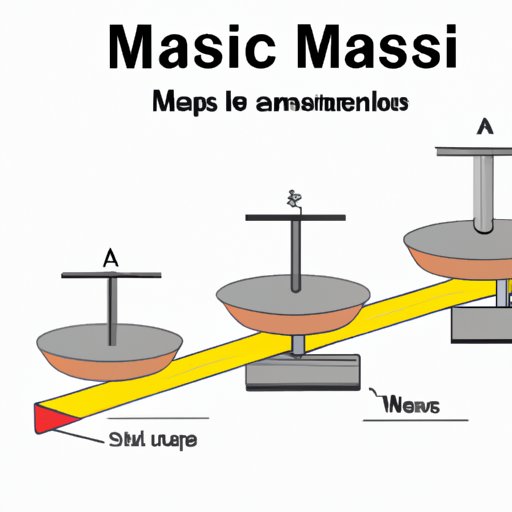
Introduction
Mass and weight are two often-misunderstood concepts in physics. Many people use the terms interchangeably, but they are not the same thing. In this article, we will explore the key differences between mass and weight and clear up some common misconceptions. Our aim is to help readers grasp these concepts so they can apply them in various situations, including scientific experiments and everyday life.
Mass vs Weight: Understanding the Key Difference
Mass refers to the amount of matter an object contains, regardless of its volume or location. It is a scalar quantity measured in kilograms (kg) and remains constant in different locations in the universe. In contrast, weight refers to the force exerted on an object due to gravity and is calculated by multiplying the object’s mass by the acceleration due to gravity (g), which is approximately 9.81m/s². Thus, weight is a vector quantity and is measured in newtons (N).
There are various devices and techniques to measure mass, from simple balance scales to sophisticated electronic balances. Mass can be determined by comparing the object of interest to a known standard mass, such as a calibration weight. In contrast, weight can be measured using a spring scale or electronic scale calibrated in newtons.
It’s worth noting that weight can change depending on the location and environment. For example, an object that weighs 50N on Earth would weigh just over 13N on the moon, which has a weaker gravitational field.
Clearing Up the Misconception: The Real Difference Between Mass and Weight
Despite the differences between mass and weight, people often use the terms interchangeably without realizing they are not the same thing. This confusion can lead to errors in calculations and measurements. For example, a person may say “my weight is 70kg,” which is incorrect as weights are measured in newtons.
It’s important to distinguish between mass and weight because they have very different units of measurement and meanings. Mass refers to the amount of matter an object contains, while weight is the force exerted on an object by gravity. Understanding the difference can help scientists and engineers make accurate calculations and design experiments or machines that require precise measurements.
Mass and Weight: Definitions, Differences, and Implications
Mass can be calculated using the formula:
Mass = Density × Volume
where density is measured in kilograms per cubic meter (kg/m³) and volume is measured in cubic meters (m³). We use mass to determine the amount of a substance present in a sample and to calculate other physical properties, such as density, specific heat, and energy.
Weight is given by the formula:
Weight = Mass × Acceleration due to gravity
where acceleration due to gravity is approximately 9.81m/s² on Earth. Weight is used in various situations, such as measuring the force exerted by an object on a surface or calculating the amount of load that a structure can bear.
The difference between mass and weight has implications in various scenarios. For example, astronauts have to account for the varying gravitational fields when performing experiments or operating machines in space. In sports, weight classifications are used to ensure fairness and safety, such as in wrestling and boxing. In everyday life, understanding the difference between mass and weight can help us measure the amount of ingredients in a recipe or load on a truck accurately.
A Beginner’s Guide to Mass and Weight: Understanding the Basic Physics Concepts
To understand mass and weight, it is useful to have some familiarity with physics concepts, such as gravity and Newton’s laws of motion.
Gravity is the force that attracts two objects with mass towards each other. It is what gives weight to objects on Earth and other celestial bodies. The strength of gravity depends on the mass of the objects and their distance from each other. The more massive an object is, the stronger its gravitational pull.
Newton’s laws of motion describe the relationship between motion and forces. The first law states that an object at rest or in motion will continue to do so unless acted upon by an external force. The second law relates force, mass, and acceleration as follows:
Force = Mass × Acceleration
The third law states that for every action, there is an equal and opposite reaction.
Why Mass and Weight are Not the Same: A Simple Explanation
In summary, mass refers to the amount of matter in an object, while weight is the force exerted on an object by gravity. Mass is measured in kilograms, while weight is measured in newtons. Although these two terms are related, they should not be used interchangeably, as they are distinct physical properties. It is crucial to understand the difference between mass and weight to make accurate calculations and measurements in science and engineering fields.
The Importance of Understanding the Difference Between Mass and Weight in Science and Everyday Life
Scientists, engineers, and other professionals rely on accurate measurements of mass and weight to design machines and structures, perform experiments, and make predictions. Understanding the difference between mass and weight is critical in these fields, as confusion between the two terms can lead to costly mistakes or dangerous errors.
In everyday life, we encounter situations that require us to measure mass or weight, whether it’s weighing ourselves or measuring the ingredients in a recipe. Knowing how to use the correct units of measurement and concepts can help us achieve better outcomes and avoid problems.
Conclusion
Mass and weight are two essential physical properties that are often misunderstood and used interchangeably. This article has explained the key differences between mass and weight, the units of measurement and formulas used to calculate them, and why it’s crucial to distinguish between them. By understanding these concepts, readers can make more accurate calculations and measurements in various fields, such as science, engineering, and everyday life. Remember to use the appropriate units of measurement and keep in mind the difference between mass and weight in your future experiments or activities.
Further Reading/Resources:




